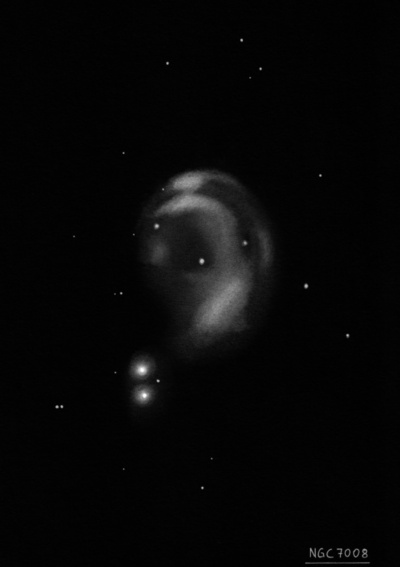
80mm (9/10/07): the planetary was faintly visible in the finder at 25x using an OIII filter.
William Herschel discovered NGC 7008 = H I-192 = h2099 on 14 Oct 1787 (sweep 765) and recorded "cB, strong nebulosity of an irregular square figure. Seems to contain faint large stars, about 3' l and 2 1/2' broad." Two nights later (sweep 768) he noted "the stars which are visible in it, do not seem to belong to it." On sweep 211, JH logged "L; E; r; has an appearance of two nuclei or points of greatest condensation; it touches a fine double star [h1606 = 9.3/10.2 at 18"]." R.J. Mitchell, LdR's assistant on 19 Aug 1855, recorded "seen as in sketch [PT 1861, pl XXX, fig 37]. 3 st in it, F neby reaches nearly up to the star sf; B knots in it, the nf one seems triangular in shape and sometimes I thought it split up by a dark line from sf to np."
Based on Crossley photographs taken at Lick, Heber Curtis (1918) reported "irregular ring structure indicated; the dimensions are 86"x69" in p.a. 20°. The two brightest patches are at the north.. three stars lie in roughly circular gaps in the nebulosity..."
In a 2001 issue of Amateur Astronomy magazine, Eric Honeycutt called NGC 7008 the "Fetus Nebula" due to its appearance in his 22-inch telescope.
200/250mm - 8" (9/11/82): unusual structure, curves and extends further south on the west side. A faint star is embedded.
300/350mm - 13" (9/11/82): bright planetary with unusual structure and several stars involved. The striking complete annular ring is elongated SW-NE. A mag 14 central star mag is visible as well as a mag 14 star at the NE edge and a faint star is off the west edge. A small brighter knot marks the NE end. The planetary is located just north of h1606 = 9.3/10.5 at 18" separation.
400/500mm - 17.5" (6/28/00): this beautiful, highly structured PN is situated just north of a wide double star (9.2/10.5 at 18"). At 280x, the annular oval is elongated SSW-NNE, ~90"x65". A bright 30" irregular knot is prominent at the NE end. The SW end of the major axis has a fainter condensation and the rim is clearly dimmest near the double star. The mag 14 central star shines steadily as does a slightly fainter mag 14.5 on the NE edge. Just off the west edge is another 14th magnitude star. The darker center is faintly luminous and the surface brightness is irregular over the entire oval giving a mottled, wispy appearance.
900/1200mm - 48" (10/24/14): We had a superb view of NGC 7008 unfiltered at 488x and 610x. This irregular, annular planetary extended ~1.5'x1.2' SSW-NNE with a roughly oval outline, except on the southwest end. Several stars are involved or just off the edge, including h1606 = 9.6/11.7 at 19” separation, which is just off the SSE edge. A very bright, elongated knot is at the NNE edge of the rim. A larger elongated knot is just on its inside (towards the central star), with the pair of close knots virtually attached. On the opposite SSW end is the next brightest region, extending nearly 45° along the rim. This larger glow spreads irregularly into the darker center and dims. Another brighter knot is on the WNW edge of the rim (probably K 4-44), just northeast of a mag 14 star that is close off the west edge. Finally, another slightly brighter knot is at the east edge of the rim, close south of a mag 14 star on the northeast side. The entire southwest side appears as if it was "nibbled" around the edges, as part of the outer edge is missing. A mag 13.5 star sits in the center of the darker interior with the central "hole" darkest immediately east of the central star. Another darker region is in the southeast quadrant just north of h1606.
Notes by Steve Gottlieb